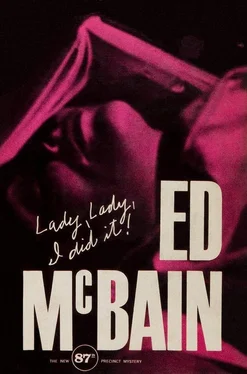“Thirty-six. Am I close?”
“I’ll be thirty-four next month.”
“Well, that’s pretty close.”
“Yes, you’re a very observant witness, Miss Klein. I wonder if I could sum this up for us. You say you saw a white man of about thirty-eight, average height, and he was wearing a black raincoat, a black cap, and sunglasses. He wore no gloves, he was holding a big gun in each hand, and you noticed no scars or deformities. Is that about it?”
“That’s it exactly,” Miss Klein said.
Now, obviously, Miss Klein’s “exactly” and Mr. Fennerman’s “exactly” did not exactly add up to a picture of exactness. Willis had not yet read the report typed up by Lieutenant Byrnes and therefore had no way of knowing that the two descriptions of the same man — while agreeing on certain points — varied on a few essentials. For example, Mr. Fennerman had said the killer was a tall man, perhaps six feet, perhaps more. Miss Klein, on the other hand, described the killer as being of average height, five-nine or five-ten. Fennerman had said that the killer was wearing a tweed overcoat and that the overcoat may have been blue. Miss Klein said he was wearing a black raincoat. Fennerman: gray fedora. Klein: black cap. Fennerman: black gloves. Klein: no gloves,
Willis knew nothing as yet of the discrepancies, but had he known he would have been overly surprised. He had been questioning people about the details of committed crimes for a long time now and had discovered rather early in the game that most eyewitnesses had only the faintest notion of what had really taken place. Whatever the reason — the excitement of the moment, the speed of the action, the theory that participation blurred objectivity — whatever the reason an eye-witness description of any chosen event had a peculiar way of leaping into that rarefied atmosphere bordering on fantasy. He had heard the most bizarre contradictions during his years on the police force. He had heard housewives describing in total inaccuracy the clothing their husbands had worn when leaving the house that morning. He had heard pistols described as shotguns, razor blades described as knives, blondes described as brunettes, tall men as short men, fat men as thin men, and, in at least one case, a voluptuous eighteen-year-old red-headed girl described as a dark-haired man in his early twenties.
Willis still asked the questions because it was all part of the game. The game was something like parlor analysis, where the cops listened to each fantastic report and tried to piece together from the subjective dreamlike accounts a picture of objective reality. This picture was often impossible to obtain from the fragmentary distortions. Even when the criminal was finally apprehended, his account of the actual crime was tainted by the same subjective distortion. It made things a little difficult. It sometimes made a thoughtful cop like Willis wonder about the reality of a bullet-riddled body on a bookshop floor.
He thanked Miss Klein for her courtesy and her time and left her alone to take her pill and worry about her brother’s dinner.
By the end of that day, Friday, October 13, all four survivors of the bookshop massacre had been questioned concerning the event itself and the identity of the killer. In the unaccustomed silence of the squadroom, Detective Steve Carella sat down with the four typewritten reports and tried to make some sort of sensible correlation. He worked in pencil on the back of a DD report, listing first the names of the witnesses and then their descriptions of the killer. When he finished his list, he looked at it sourly, scratched his head, and then read it over again.

The witnesses seemed to agree, wholeheartedly on only three points: the killer was male, and white, and wearing sunglasses. From their varying estimates of the man’s age, Carella found it impossible to make an intelligent guess. Two of the witnesses thought the killer was tall, and two thought he was of average height — so Carella safely reasoned that, at least, the man was not short. Only one of the witnesses, Miss Klein, thought he was wearing a raincoat, whereas the other three agreed it was an overcoat. They could not get together on the color of the coat, but two of them were certain it was brown. In any case, it was reasonable to assume the coat was dark. Carella was willing to buy the gray fedora since three of the four witnesses claimed this was what they had seen. The gloves were a toss-up. The scar seemed to have been invented by Miss Deering; two of the other witnesses said there had been no scars, and Mr. Fennerman hadn’t commented at all, a curious circumstance if there had been any scars. No, Carella was willing to rule out the possibility of the man’s carrying a scar. Concerning the number of guns he’d carried, the majority of the witnesses seemed to agree it was two. Again, Miss Deering’s imagination had taken hold, this time in understatement. Miss Klein said the guns were big, and Mr. Woody — who himself owned a .22, for which he had a premises permit — claimed both guns were .22s.
Carella put a clean sheet of paper into his typewriter and began typing from his penciled notes.
SUSPECT
Male
White
Not short
Sunglasses
Dark overcoat
Gray fedora
Gloves (?)
No scars, marks, deformities
Two guns
That was a lot to go on.
Sure.
That was a whole hell of a lot to go on.
He could remember the day they met...
He was waiting in the hallway outside apartment 47, after having pressed the bell button. The door opened suddenly. He had heard no approaching footsteps, and the sudden opening of the door surprised him. Unconsciously, he looked first to the girl’s feet. She was barefoot.
“My name is Bert Kling,” he said. “I’m a cop.”
“You sound like the opening to a television show,” she answered.
She stared at Kling levelly. She was a tall girl. Even barefoot she reached to Kling’s shoulder. In high heels she would give the average American male trouble. Her hair was black. Not brunette, not brownette, but black, a total black, the black of a starless, moonless night. Her eyes were a deep brown, arched with black brows. Her nose was straight and her cheeks were high, and there wasn’t a trace of makeup on her face, not a tint of lipstick on her wide mouth. She wore a white blouse and black toreador pants, which tapered down to her naked ankles and feet. Her toenails were painted a bright red.
She kept staring at him. At last, she said, “Why’d they send you here?”
“They said you knew Jeannie Paige.”
That was the beginning of Claire Townsend, or at least the beginning of her for him. He was still a patrolman at the time, and he had gone to her in plain clothes and on his own time to ask questions about a dead girl named Jeannie Paige, the sister-in-law of an old friend. She answered all his questions graciously and easily, and at last, when there were no more questions to ask, he rose and said, “I’d better be going. That is dinner I smell, isn’t it?”
“My father’ll be home soon,” Claire said. “Mom is dead. I whip something up when I get home from school.”
“Every night?” Kling asked.
“What? I’m sorry...”
He didn’t know whether to press it or not. She hadn’t heard him, and he could easily have shrugged his comment aside. But he chose not to.
“I said, ‘Every night?’ ”
“Every night what?”
She certainly was not making it easy for him. “Do you prepare supper every night? Or do you occasionally get a night off?”
Читать дальше


![Дэвид Лоуренс - Lady Chatterley's Lover [С англо-русским словарем]](/books/26613/devid-lourens-lady-chatterley-s-lover-s-anglo-thumb.webp)










